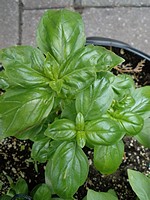 Basil has been widely grown in the Mediterranean for centuries, and is the first herb most people think of in an Italian Herb Garden.
Basil has been widely grown in the Mediterranean for centuries, and is the first herb most people think of in an Italian Herb Garden.
And, Genovese basil –originating from the Genoa region of Italy — is the hands-down favourite basil in many Italian herb gardens.
Genovese basil leaves are large and sweet. This basil is also highly aromatic, with that distinct basil aroma that makes you dream of Italian food.
Botanical Name: Ocimum Basilicum Genovese
How To Grow Genovese Basil
Genovese Basil is an annual herb — a tender annual in much of the northern hemispheres. It is one of the most popular herbs grown today in home gardens.
Grow Genovese Basil From Seed
Genovese Basil grows easily from seed. Sow outdoors in the spring when all danger of frost has passed.
Cover seeds with a thin layer of soil (1/8”), and gently press the soil where you have sown the Genovese basil seed so the soil and seed make contact.
Keep the seeds moist constantly until they have sprouted.
Genovese basil may also be started indoors from seed and transplanted into the garden when all danger of frost has passed.
Transplanting Your Genovese Basil
Wait until all danger of frost is past before permanently planting your Genovese basil into the garden. This applies whether you are transplanting your own basil seedlings or nursery-bought basil plants. Frosts and low temperatures at night can destroy a basil plant in one night.
Genovese Basil In Containers
Genovese basil also grows well in containers. Grow a few Genovese basil herb plants in a pot on the backyard deck or windowsill , for easy access just outside your kitchen. The closer your basil is to your kitchen, the more you will be inclined to use it.
As Your Genovese Basil Grows
Genovese basil likes full sun, but can tolerate light shade. It prefers moist, rich, well-drained soil. After planting your basil, add compost to enrich the soil.
Basils likes to be pruned, and Genovese basil is no exception. To encourage bushy plants, and extend the productivity of your Genovese basil plant, prune your basil plant regularly. And of course, there are many wonderful culinary uses for the pruned pieces of this wonderfully fragrant herb.
Keep your Genovese basil plant from flowering. When a flowering spike begins forming, cut off the top of the stem along with at least one set of leaves.
How To Harvest Genovese Basil
Harvest your Genovese basil by cutting at the stem. Leave at least two leaves on the stem to encourage new growth.
By cutting off stems of basil, rather than plucking individual leaves off the stem, your basil plant will grow bushier, and you will increase your supply of basil. Remember, basil is an herb that likes to be pruned.
Using Your Genovese Basil in the Kitchen
Its sweetness and fragrant aroma makes Genovese basil THE basil for fresh dishes. Young Genovese basil leaves have the brightest sweetest flavour.
This superb basil is the classic basil used for pestos. It is also an excellent basil to use in Caprese salad.
Genovese basil is a versatile herb that can be added to pasta sauces, pizzas and stews. Chicken and fish dishes are also enhanced with the addition of chopped Genovese basil.
Genovese basil also freezes well for winter use. Note that when you freeze basil, it will turn dark.
Frozen basil is best used in cooked dishes, added to the dish right from its frozen state.
Have fun growing and eating this Italian kitchen garden staple – Genovese basil herb.
To your herb garden success,
Herb Garden Gal
Copyright © 2011 www.HerbGardenGal.com. All rights reserved.
_________
Want to use this article in your Ezine or Website? You can, as long as you include the complete article and the Copyright information.
